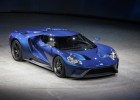Ford F-150 EcoBoost ##Q##Hero##Q## Engine Laid Bare In Front of Live Audience In Final Web Documentary
The block, pistons, turbos, crankshaft, valves and other internal parts of the 3.5-liter F-150 EcoBoost “hero” engine are still within rigid factory specifications after enduring testing that simulated 10 years of wear or about 160,000 miles.
In an unprecedented – and high-stakes – public reveal, Ford engineers disassembled the engine for the first time in front of a live audience of nearly 1,000 at the North American International Auto Show (NAIAS) in Detroit.
“I was amazed that, first, the engine looked as good as it did, and second, Ford took the chance of opening it up in front of the public,” said Gary Heinz, coordinator of the Automotive Student Service Education Training program at Henry Ford Community College in Dearborn.
“You know that in a Detroit crowd, there are a lot of auto mechanics who know a good engine from a worn out one,” said Heinz, a long-time engine mechanic who watched the teardown with a group of students.
Heinz said he credits the engine design, the high-quality manufacturing process and the precise tolerances between the moving parts with the low wear found on the components.
Over the past three months, EcoBoost engine No. 448AA performed a series of rigorous events to prove out the new technology##Q##s durability. Specifically, the engine hauled 55 tons of lumber, ran at full throttle for 24 straight hours towing 11,300 pounds, beat competitors##Q## larger V8 engines in an uphill towing competition and completed the world##Q##s toughest desert endurance race, the SCORE Tecate Baja 1000, in Mexico.
Said one spectator: “Ford has a lot of guts to take this apart in public, especially after all that has been done to this engine.”
Ford powertrain technician Chris Rahill has torn down nearly 2,000 engines in his 20-year career at Ford Motor Company. He said the engine he disassembled is not even close to being near the end of its life.
“Given the intense engineering and research and the severity of the durability tests we run that go into all Ford engines, I##Q##m not at all surprised how good this engine looked,” said Rahill. “Everything was within manufacturing specification. Nothing was out of the norm.”
The comparative lack of engine sludge/grime indicates that the engine##Q##s PCV (positive crankcase ventilation) system and the recommended Motorcraft 5W-30 synthetic blend motor oil – available off the shelf – worked in harmony to contribute to clean engine operation.
The PCV system essentially “recycles” crankcase gases back into the intake for reburning, which contributes to improved fuel economy and lower emissions.
In terms of oil consumption, the 2011 F-150 EcoBoost has a 10,000-mile oil change interval and includes an intelligent oil life monitor (IOLM). The IOLM uses actual engine and vehicle operating conditions to more precisely calculate anticipated service intervals, depending on vehicle operating conditions, as follows:
Up to 10,000 miles: normal commuting with highway driving
5,000 to 7,500 miles: trailer tow/high-load driving
3,000 to 5,000 miles: short-trip usage, extreme temperatures
Instead of using a predetermined interval schedule (either by time or mileage), the IOLM tells customers, based on their driving habits and engine operating conditions, when to change the oil through simple communications in the message center.
Intense testing key to durability
The F-150 EcoBoost engine saw its first action on the dyno in July. Engineers punished it in temperature and load extremes simulating a regimen tougher than any customer##Q##s.
“In the initial dyno test, we accelerated real-world mileage or engine cycles,” said Fabien. “We ran at much higher engine speeds and higher torque levels and added in more extreme temperature swings than a customer can possibly do. We can go from minus-20 coolant temperature to 235 degrees within three minutes at peak power.
“Essentially, with these accelerated tests, we can run conditions customers may be able to get into for a short period of time, but we do it for hours on end.”
After the dyno testing, most engines would be ready to be rebuilt or retired, but the EcoBoost torture test was just beginning.
Source: NAIAS & Ford.




















